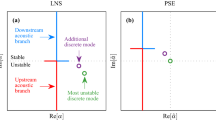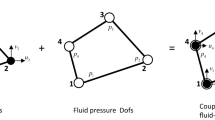Abstract
The parabolized stability equation (PSE) method has been proven to be a useful and convenient tool for the investigation of the stability and transition problems of boundary layers. However, in its original formulation, for nonlinear problems, the complex wave number of each Fourier mode is determined by the so-called phase-locked rule, which results in non-self-consistency in the wave numbers. In this paper, a modification is proposed to make it self-consistent. The main idea is that, instead of allowing wave numbers to be complex, all wave numbers are kept real, and the growth or decay of each mode is simply manifested in the growth or decay of the modulus of its shape function. The validity of the new formulation is illustrated by comparing the results with those from the corresponding direct numerical simulation (DNS) as applied to a problem of compressible boundary layer with Mach number 6.
Similar content being viewed by others
References
Herbert, T. and Bertolotti, F. P. Stability analysis of nonparallel boundary layers. Bulletin of the American Physical Society, 32, 2079–2086 (1987)
Herbert, T. Parabolized stability equations. Annual Review of Fluid Mechanics, 29(1, 245–283 (1997)
Bertolotti, F. P. and Herbert, T. Analysis of the linear stability of compressible boundary layers using the PSE. Theoretical and Computational Fluid Dynamics, 3(2, 117–124 (1991)
Chang, C. L., Malik, M. R., Erlebacher, G., and Hussaini, M. Y. Compressible stability of growing boundary layers using parabolized stability equations. 22nd Fluid Dynamics, Plasma Dynamics and Laser Conference, American Institute of Aeronautics and Astronautics, Reston (1991)
Bertolotti, F. P., Herbert, T., and Spalart, P. R. Linear and nonlinear stability of the Blasius boundary layer. Journal of Fluid Mechanics, 242(1, 441–474 (1992)
Esfahanian, V., Hejranfar, K., and Sabetghadam, F. Linear and nonlinear PSE for stability analysis of the Blasius boundary layer using compact scheme. Journal of Fluids Engineering, 123(3, 545–550 (2001)
Zhang, Y. M. and Zhou, H. Verification of parabolized stability equations for its application to compressible boundary layers. Applied Mathematics and Mechanics (English Edition), 28(8), 987–998 (2007) DOI 10.1007/s10483-007-0801-3
Zhang, Y. M. and Zhou, H. PSE as applied to problems of secondary instability in supersonic boundary layers. Applied Mathematics and Mechanics (English Edition), 29(1, 1–8 (2008) DOI 10.1007/s10483-008-0101-7
Zhang, Y. M. and Zhou, H. PSE as applied to problems of transition in compressible boundary layers. Applied Mathematics and Mechanics (English Edition), 29(7, 883–840 (2008) DOI 10.1007/s10483-008-0701-8
Dong, M., Zhang, Y. M., and Zhou, H. A new method for computing laminar-turbulent transition and turbulence in compressible boundary layers—PSE+DNS. Applied Mathematics and Mechanics (English Edition), 29(12, 1527–1534 (2008) DOI 10.1007/s10483-008-1201-z
Kachanov, Y. S. and Levchenko, V. Y. The resonant interaction of disturbances at laminar turbulent transition in a boundary layer. Journal of Fluid Mechanics, 138(1, 209–247 (1984)
Su, C. H. Physical implication of two problems in transition prediction of boundary layers based on linear stability theory. Science China Physics, Mechanic and Astronomy, 57(5, 950–962 (2014)
Author information
Authors and Affiliations
Corresponding author
Additional information
Project supported by the National Natural Science Foundation of China (Nos. 11202147, 11472188, 11332007, 11172203, and 91216111) and the Specialized Research Fund (New Teacher Class) for the Doctoral Program of Higher Education (No. 20120032120007)
Rights and permissions
About this article
Cite this article
Zhang, Y., Su, C. Self-consistent parabolized stability equation (PSE) method for compressible boundary layer. Appl. Math. Mech.-Engl. Ed. 36, 835–846 (2015). https://doi.org/10.1007/s10483-015-1951-9
Received:
Revised:
Published:
Issue Date:
DOI: https://doi.org/10.1007/s10483-015-1951-9




